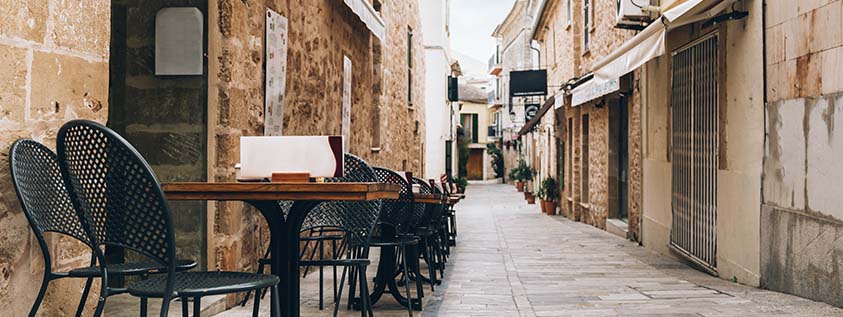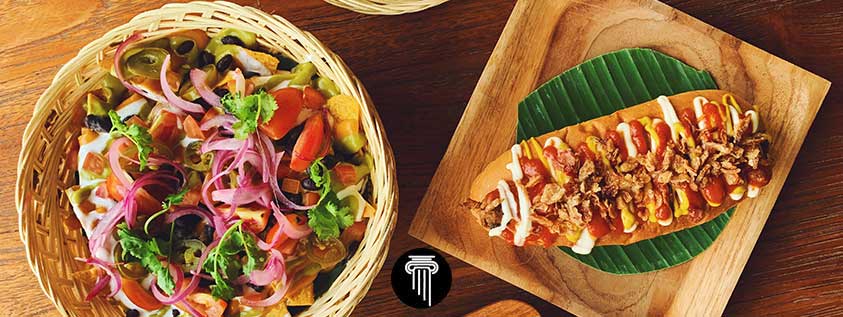How To Order Food in Spain Like a Local
Food in Spanish culture is not just a way to nourish the body but also an activity that brings people together. It is often used to bond and share stories between friends. Spaniards take immense pride in their cuisine, whether attending a concert or dining before the movies. As such, knowing how to order food correctly in Spain is essential. If you want to blend in with the locals when ordering food in Spain, start by knowing the language. While ordering food in Spain can be intimidating if you don’t speak the language, with a few simple tips, even the most novice traveler can master it. Most restaurants do not take reservations, so be sure to show up early if it’s a popular spot.
This comprehensive guide on the distinctive cuisine of Spain will not only help you decide what and where to order but also provide some useful tips. It might not be an exact science, but with our handy advice, your visit will surely be delicious.
Content
How do you order meals in Spain?
Saying hello
When you first enter the restaurant, greeting the staff is always polite. Depending on what time of day it is, say “Buenos días” (Good morning), “Buenas tardes” (Good afternoon), or “Buenas noches” (Good evening/night). This will show your respect for their culture and make them feel appreciated.
To get the ball rolling, take the initiative by saying a warm “¡Buenas!” as an informal greeting, no matter the time of day. Chances are you will be met with a cheerful “Qué tal?” (“How’s it going?”), You can reply with this classic – “Muy bien, gracias. Y usted?” (Very good, thanks. And you?). Whether in or outdoors, start off your conversation on the right foot and let them know you’ve got some Spanish up your sleeve. You can start with the following:
—Hola, ¡Qué tal!
(“Hi there! How are you doing?”)
—Muy buenas. De inmediato prepararé una mesita para ustedes.
(“Hello/Very good indeed. I’ll immediately prepare a table for you all.”)
The word “buenas” is multifunctional and can be used as a polite way to greet someone regardless of the time of day. It’s appropriate for afternoons (“buenas tardes”), evenings (“buenas noches”), or mornings (“buenos días”). Though it may sound odd given that día is masculine, you don’t need to worry about getting into details concerning weekend activities; simply use buenas instead.

Ordering
Once you’ve been seated, it’s time to order your food. Don’t be intimidated by all the Spanish words for food on the menu –just ask for help if you don’t understand anything. Most restaurants will offer several traditional dishes such as paella, tortilla española (Spanish omelette), and gazpacho (cold tomato soup). Other typical meals include:
- Patatas bravas (potatoes with a spicy sauce).
- Croquetas de jamón (ham croquettes).
- Bacalao al ajillo (cod with garlic).
When ordering, you can simply say, “Quisiera…” (I would like) followed by what you want to order. For example:
—Quisiera una ensalada de patatas.
(“I’d like a potato salad.”)
—Qué desea para beber?
(“What would you like to drink?”)
—Me gustaría una botella de agua mineral.
(“I’d like a bottle of mineral water, please.”)
You can also say “Un café, por favor” (a coffee, please) or “Me gustaría una copa de vino tinto” (I’d like a glass of red wine). If you’re adventurous and want to try something new, ask the waiter, “Qué me recomienda?” (What do you recommend?).
Paying and leaving
Ready to pay? “La cuenta, por favor” is the simplest way of requesting your check-in Spanish; which translates to “the check please.” Alternatively, you can give a gesture of getting pinched between your thumb and index finger while making a ‘checkmark’ sign in the air – this is considered polite. If you want to pay with a credit card, just politely ask: “Puedo pagar con tarjeta?”
If your waiter keeps on avoiding you while you desperately attempt to order in Spanish, try out this phrase:
“Perdón! (Levanta el brazo. Establece contacto visual). Puedes traer la cuenta? (Subir las cejas ligeramente. Hacer un pequeño gesto con los dedos en el aire para señalar que está lista.)”
“Excuse me. (Raise arm. Make eye contact). Can I get the check, please? (Gently raise eyebrows and make a small motion with fingers in the air signaling it’s ready).”
The best way to end your meal is to thank the restaurant staff for their service. In Spanish, there are many ways of expressing gratitude: “Gracias por su servicio” (Thank you for your service), “Muchas gracias por todo” (Thank you very much for everything), and “Un placer comer aquí” (It was a pleasure to eat here) are all polite ways of saying goodbye. Don’t forget to add a tip when you’re dining out in Spanish-speaking countries.
How do you order a drink in Spanish politely?
If your travels take you to a Spanish-speaking country, it’s important to know how to order drinks in Spanish politely. Broadening your horizon can open up a world of flavors and new tastes. Everywhere you go, there is something to sample and savor. From soft drinks to alcoholic drinks, here are some popular drinks’ names to help you order:
Mixed drinks (Copas)
Everyone loves beer and wine but sometimes you need something stronger. Looking for an easy-to-make drink after a long day? If so, knowing the perfect mix of drinks is essential when going on an adventure. Here are some of the most popular mixed drinks:
- Vino tinto con gaseosa (Red wine with soda)
- Cerveza con limón (Beer with lemon)
- Rom cola (Rum and Coke)
- Tequila y Limonada (Tequila and lemonade)
Alcohol-free drinks
Hiking, camping trips, or a night out with friends? Everyone needs a non-alcoholic beverage now and then. From coffee to smoothies, here are some of the most popular drinks when ordering alcohol-free drinks:
- Café con leche (Coffee with milk)
- Horchata (Rice and cinnamon drink)
- Agua con gas (Sparkling water)
- Zumo de naranja (Orange juice)
- Batido de chocolate (Chocolate milkshake)
- Calimocho (Soda water with red wine)
Red wine (Vino tinto)
Red wines are always popular when ordering drinks, a classic favorite and a staple in Spanish culture. With the Spanish sun bringing out the vibrant flavors of each bottle, you can’t go wrong with a glass of vino tinto. Whether it be an aged Rioja or a young Tempranillo – don’t forget to order your red wine with a bit of cheese or cured ham to create the perfect pairing.
—Dos copas de vino, por favor.
(“Two glasses of wine, please.”)
—Me gustaría un vaso de vino tinto.
(“I’d like a glass of red wine.”)
Soft drinks (Refrescos)
Though often overlooked, soft drinks are also popular when going out for dinner or just hanging out with friends. From soda to juices and seasonal fruit drinks, here are some of the most popular soft drinks when ordering in Spanish:
- Una Coca Cola (A Coke)
- Un zumo de naranja (An orange juice)
- Una horchata (A cinnamon rice drink)
- Un calimocho (Soda water with red wine)
Shots (Chupitos)
Shots are an easy way to get the party started, and they come with a bang in Spain. Whether it be tequila or flaming Catalan Cuban rum, there’s nothing like ordering drinks with some friends to celebrate. If you want to go all out, request the traditional chupito – a mixture of vodka, triple sec, and lemon juice.
Coffee shops
Coffee culture is a strong part of Spanish identity and the perfect occasion to practice ordering drinks in Spanish. These popular beverages can be found at almost any coffee shop throughout Spain, from a café solo (espresso) to un cortado (expresso with steamed milk) and even a chocolate milkshake.
General tips for ordering food in Spain
1. The traditional “Churros y Chocolate” combo cup is meant for dipping only. Bite into a warm and crispy churro and savor it with a mug of thick, rich chocolate – which has the consistency of molten pudding.
2. To experience local Spanish cuisine, avoid tourist restaurants as much as possible, and opt for smaller family-run establishments that will put you right at home in Spain.
3. While ordering drinks, it’s essential to be aware of the size of the glassware. A standard order consists of one “copa de vino”(small glass of wine) or a “vaso de vino into” (large glass of red wine). Larger sizes are usually offered, but you may be charged extra.
4. For those passionate about food, Spain’s portion sizes are significantly smaller than one might expect from an American meal. As a result, it is essential to be aware of this difference before you dine out!
5. If you’re unsure what something is or how it’s prepared, don’t hesitate to ask your waiter or waitress for clarification. They’re there to help you, and they’ll happily answer any questions you have.
6. When ordering, be as specific as possible about what you would like. If you’re unsure about something, it’s better to ask for clarification than to end up with something you don’t want.
7. Know the difference between “tapas” and “raciones”. Tapas are small dishes typically served as appetizers, while raciones are larger dishes meant to be shared. Remember this when ordering: You may want to order a few tapas if you’re just looking for a light meal or snack.
8. While most waiters and waitresses in Spain will speak English, it’s always appreciated if you can order your food in Spanish. Not only will this show that you’re trying to learn the language, but it will also make the experience of ordering food in Spain much more authentic.
9. In some Spanish-speaking countries, when you settle the bill, they don’t take your card away from the table; instead, they bring a card reader straight over for easy payment.

Can you get food delivery in Spain?
Yes, food delivery is very common in Spain, and many restaurants offer both traditional home delivery and online ordering options. For example, one of the most popular apps is Glovo, which allows customers to order food from hundreds of restaurants in minutes.
A word from SpainDesk
Learning how to order food in Spain like a local can be both exciting and rewarding. From tasting the unique ingredients used in Spanish cuisines such as red peppers, garlic, olive oil, and fresh seafood to practicing popular phrases like “Encantado” and “Exquisito”, you will undoubtedly leave the country with more than just a full stomach! Don’t forget to try interesting flavors such as salmorejo, calçotada or fideos de fideua. Whatever type of food you choose, make sure to savor your experience by taking time to appreciate the flavors and culture on offer. Bon Appétit!

